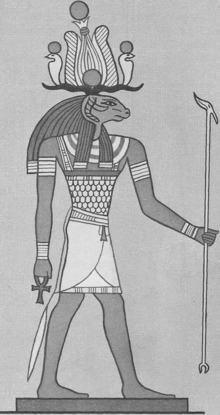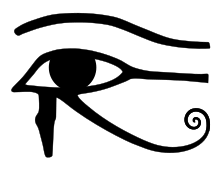Heryshaf
In Egyptian mythology, Heryshaf, or Hershef (Ancient Egyptian: ḥrj š f "He who is on His Lake"),[1] transcribed in Greek as Harsaphes or Arsaphes (Koinē Greek: Ἁρσαφής) was an ancient ram deity whose cult was centered in ancient Heracleopolis Magna. He was identified with Ra and Osiris in ancient Egyptian religion,[1] as well as Dionysus[2] or Heracles in the interpretatio graeca. The identification with Heracles may be related to the fact that in later times his name was sometimes reanalysed as ḥrj-šf.t "He who is over strength". One of his titles was "Ruler of the Riverbanks". Heryshaf was a creator and fertility god who was born from the primordial waters. He was pictured as a ram or a man with a ram's head.
| Heryshaf | |||||
|---|---|---|---|---|---|
 Heryshaf | |||||
| Name in hieroglyphs | |||||
| Major cult center | Heracleopolis Magna | ||||
| Greek equivalent | Heracles Dionysos | ||||
| Part of a series on |
| Ancient Egyptian religion |
|---|
 |
|
Beliefs |
|
Practices
|
|
Deities (list) |
|
Locations |
|
Symbols and objects
|
|
Related religions
|
|
|
Temple at Heracleopolis Magna
The site goes back to the Early Dynastic Period or the Old Kingdom of Egypt. The site was called nn-nswt in Demotic which was pronounced ǝhnes in Coptic, Heracleopolis (Magna) during the Hellenistic period and the Roman Empire and Ihnasiyya in Egyptian Arabic.[3]
No remains of the Old Kingdom temple survive. Flinders Petrie found remains of a temple at the site dating to the Twelfth Dynasty. The Twelfth Dynasty temple was rebuilt during the Eighteenth Dynasty and later refurbished during the Nineteenth Dynasty.[4] During the reign of Ramesses II, a pronaos was added to the temple. The sixteen palm columns used were taken from existing temples, possibly those of Djedkare Isesi or Sahure. Yasuoka speculates that Ramesses II's fourth son, Prince Khaemweset, may have been the official who directed this project.[5]
High Priests of Heryshaf
Many of these names are known from the Stela of Pasenhor.
- Nimlot C, son of pharaoh Osorkon II and his queen Djedmutesankh, Twenty-second Dynasty of Egypt[6]
- Ptahudjankhef, son of Nimlot C and Tentsepeh C
- Hemptah A, son of Ptahudjankhef and Tentsepeh D
- Pasenhor A, son of Hemptah A and Tjankemit
- Hemptah B, son of Pasenhor A and Petpetdidies
Nedjemankh, whose coffin was looted from Egypt in 2011 and sold to the Metropolitan Museum of Art, is also believed to have been a priest of Heryshaf.[7]
References
- Forty, Jo. Mythology: A Visual Encyclopedia, Sterling Publishing Co., 2001, p. 84.
- Antoninus Liberalis, Metamorphoses 28 (trans. Celoria) (Greek mythographer 2nd century AD)
- Reviewed Work: Ihnasya el-Medina (Herakleopolis Magna): Its Importance and Its Role in Pharaonic History by Mohamed Gamal el-Din Mokhtar, Review by: Hans Goedicke, Journal of the American Research Center in Egypt, Vol. 20 (1983), p. 119; via JSTOR
- Koichiro Wada, "Provincial Society and Cemetery Organization in the New Kingdom", Studien zur Altägyptischen Kultur, Bd. 36 (2007), pp. 347–389
- Y. Yasuoka, "Some remarks on the palm columns from the pronaos of Heracleopolis Magna", The Journal of Egyptian Archaeology, Vol. 97 (2011), pp. 31–60
- Morris L. Bierbrier, Historical Dictionary of Ancient Egypt, Scarecrow Press, August 14, 2008, p. 170
- Coffin of Nedjemankh
- Hart, George (2005). "Heryshaf". The Routledge dictionary of Egyptian gods and goddesses (2nd ed.). London, New York: Routledge. pp. 68–69. ISBN 978-0-415-36116-3. OCLC 57281093. Retrieved 16 December 2009.
External links
